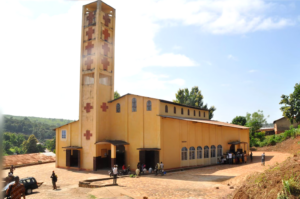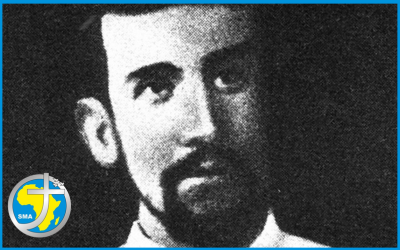This article was written by Fr Basil Soyoye, a Nigerian SMA Missionary now based in Castelnaudary, France. It tells the story of one of the earliest Irish SMA Missionaries, Fr Jeremiah Moran who is considered as one of the founding pillars of the Church in Togo.
Jeremiah Moran was born in Ballinree, in the diocese of Killaloe, Ireland in 1859. He was one of four children born to Rebecca and Daniel Moran. After secondary school he entered the major seminary of the Society of African Missions (SMA) in Lyon (France) in 1879 when he was twenty years old. He took his oath and became a member of the SMA on June 10, 1881 and was ordained a priest on July 26, 1884 in Lyon. Two months later, in September, without returning to see his family in Ireland, Father Moran was sent to the apostolic prefecture of Dahomey which includes present-day Benin and Togo.
Upon arrival, he stayed in Agoué (now a district in the Department of Mono in Benin) where he began to learn Gengbé, one of the local languages. In December 1885, Father Moran left with Father Beauquis under the leadership of Fathers Ménager and Baudin to found a mission in Adangbé, where they settled. He was appointed as superior of this mission dedicated to the Immaculate Conception. However, the missionaries did not succeed in establishing themselves in Adangbé and they went to Atakpamé where the old chief, Abassam, welcomed them with joy. Unfortunately, the foundation there also proved difficult, but nevertheless, Fathers Moran and Beauquis remained. They gave witness to the Gospel of Jesus. They treated the sick. They resolved disputes. They built. The good deeds of the missionaries attracted the anger of the witch-doctors and healers who, in addition to losing their influence over the population, also saw their income drop considerably. As a result, the two missionaries were poisoned on Holy Saturday (Saturday April 24), 1886. Using an emetic, they managed to expel the poison. Father Beauquis recovered quickly but Father Moran was ill for a long time. Almost recovered, Father Moran went back down to Agoué, to rest and recuperate with his colleagues and to “stock up on provisions”. It should be noted that on Easter Sunday, Chief Abassam was also poisoned and he died on May 6.
Upon returning from Agoué after convalescing, the the same troubles and difficulties remained. The local Chiefs and witch-doctors became increasingly jealous of the growing influence the missionaries had over the population. In December, Father Beauquis went back to the coast, while Father Moran, left alone, tried to calm the envy and jealousy of the traditional leaders with gifts.
In January 1887, Father Lecron, the new superior of the prefecture, came to Atakpamé with Father Beauquis and they also brought needed provisions. Father Lecron, a man of rare gentleness, succeeded in bringing joy and happiness to the mission. He provided wise guidance on how to manage the local leaders and succeeded in calming the situation. After his departure the missionaries of Atakpamé lived in peace for a few months. Land was even acquired on a hill nearby and materials were prepared for construction. They continued to care for the sick and increasingly acquired a great reputation.
This did not suit those whose influence was being undermined and so it was decided to kill the missionaries. They were, once again, poisoned, this time by means of poison mixed into palm wine. A young boy whom they often sent to the market, brought them palm wine that was poisoned by the seller. They drank it and soon afterwards experience severe pain. They immediately took an emetic to counter the poison. This worked on Father Beauquis but failed to bring relief to Father Moran. In a letter dated October 16, 1887, Father Augustin Planque (the SMA Superior General at the time) gives the following details: “Father Moran was ill for eight days and from the first day he knew his death was close. He remained, calm and smiling, prepared to die and did not, for a single moment, depart from his deep trust in God. He said that God asked him for his life as the foundation of the mission dear to his heart .” Father Moran died on August 7, 1887, at age 28. The people of Atakpamé and the surrounding villages attended his funeral. His body was carried by the two sons of the former chief, the one who had welcomed the missionaries and who, also poisoned, had died for it.
The Atakpamé mission was reopened in 1900 and the Fathers of the Divine Word succeeded in finding the bones of Father Moran and gave them a suitable burial in the town’s new Catholic cemetery.
Here is an quote from the article by Togolese journalist, Charles Ayetan, entitled, “Father Jeremiah Moran, martyr of evangelization in Togo,” published in the International Cross on July 30, 2021: “This drama is considered by many to be the founding martyrdom of the Church.” Mgr Joseph Strebler, first archbishop of Togo in his preface to the work History of the Catholic Church in Togo [1] reflects a similar view, he writes; “ The history of the Church of Togo is extraordinary! It begins with the death of the young Father Moran, SMA, poisoned at Atakpamé in 1887.“

During the centenary of his death, in August 1987, the remains of Father Moran were reburied in the Sainte Famille Church, the former cathedral of Atakpamé, and the diocesan seminary of Datcha-Tchogli was named ‘Jérémie Moran’ in his honour during the laying of the its foundation stone in 1990 by Cardinal Jozef Tomko.
At the enthronement of Mgr Julien Kouto, third bishop of Atakpamé, Mgr Philippe Kpodzro, archbishop emeritus of Lomé, evoked the memory of Moran in these words: “Atakpamé fertilized in 1887 by Father Jérémie Moran, first priest of Jesus Christ , SMA missionary, who gave his life in the line of martyrs, so that the Church in Togo would sprout in abundance.” “The history of the evangelization of Atakpamé represents a founding event of the Mission in Togo. It is considered its prehistory…” writes Father Joseph Amegbleame, theologian, at the Catholic University of West Africa, University Unit of Togo [2]. »
[1] Karl Müller, History of the Catholic Church in Togo (1892-1967), Lomé, Éditions Librairie Bon Pasteur, 1968, p. 11.
[2] Identity confinement and appearance of integration in the mission of Jérémie Moran, sma, + August 7, 1887, article, Présence Chrétienne No. 302 of Thursday July 22, 2021, pp.9, 10.

